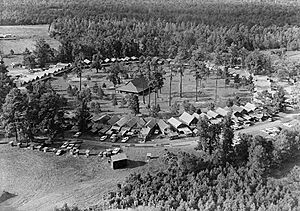Indian Fields Methodist Campground facts for kids
Quick facts for kids |
|
|
Indian Field Methodist Campground
|
|

The Tabernacle at the Indian Field Methodist Campground
|
|
| Nearest city | St. George, South Carolina |
|---|---|
| Built | 1848 |
| NRHP reference No. | 73001707 |
| Added to NRHP | March 30, 1973 |
Indian Field Methodist Campground is a special place where people gather for camp meetings. These meetings are for the Methodist Church and are held in Dorchester County, South Carolina. The campground is found on SC Route S-18-73, just off US Route 15. It is about 5 miles (8 km) north of Saint George.
The Indian Field Methodist Campground was built in 1848. For over 160 years, it has been a site for religious gatherings. It is linked to the Indian Field United Methodist Church, which is located nearby. This special campground was named a historic district on the National Register of Historic Places on March 30, 1973.
Contents
A Look Back: History of the Campground
Religious camp meetings were very important in the early 1800s. They helped Protestant churches grow in the countryside of the United States. These meetings brought together more people than a single church could. Camp meetings often lasted about a week. They were both social events and religious occasions for everyone who attended.
How Camp Meetings Started
A typical camp meeting usually began with a simple brush arbor. This was a shelter made from branches. People would set up tents and wagons around it. Over time, a chapel or a tabernacle would be built to replace the arbor. Wooden cabins, often called "tents," were built to replace actual tents.
The Local Church
The Indian Field United Methodist Church is located about 2 miles (3 km) north of the campground. This church started in 1787. Its first building was about 3 miles (5 km) east of the Rosinville community. A second church was built around 1819. The third church was finished in 1886. The church building used today was completed in 1955.
Campground's Beginnings
The very first Indian Field Campground meeting happened on a farm in the late 1700s. It was probably near the first church building. Bishop Francis Asbury wrote in his journal that he preached at "Indian Fields" in 1801 and 1803. It is not clear if he preached at the campground or the church. Other records suggest this campground was officially started in 1810.
In 1838, the campground moved to its current spot. The buildings that are there today were constructed in 1848. The campground was repaired and updated in 1970. Sadly, in 1995, a fire damaged some buildings at the campground.
What the Campground Looks Like
The campground today has a main tabernacle in the center. Around it are ninety-nine wooden cabins. These cabins are still called "tents." Even though it's often said they are in a circle, they are actually arranged more like an octagon.
The Tabernacle
The tabernacle is a large wooden pavilion. It has a special roof called a gablet roof. The roof's wooden beams can be seen, and it is held up by wooden posts. Inside, there is a raised stand for the preacher at one end. There are also three sections of wooden pews. More than 1,000 people can sit inside.
The "Tents" or Cabins
The "tents" are two-story cabins with metal roofs. Each cabin has a different inside layout. However, most have two bedrooms upstairs with a staircase in the middle. Downstairs, there is usually a dining area at the front and another bedroom at the back. In the past, boys and girls slept in separate upstairs bedrooms. The downstairs bedroom was for older family members.
The rooms downstairs might be connected by a hallway. Or, each room might have its own door to the outside. The floors downstairs are made of dirt. During camp meetings, these floors are usually covered with straw. The cooking area is under a small shed attached to the back of each cabin. There is a brick or cinderblock fireplace for cooking with wood. There is also usually a small room for the cook to stay in.
Other Buildings and Features
The preacher's cabin is a single-story building. It is larger and taller than the other cabins. It has a four-panel door with windows on each side.
There is a paved road that goes around the campground. Outside this road, each cabin has its own privy (an outdoor toilet). In the past, there were shared water wells in front of the cabins. There were also stands for burning pine knots to light up the area at night. Today, each cabin has its own water and electricity.




